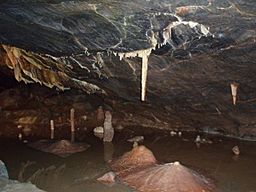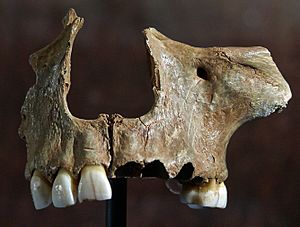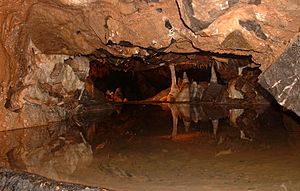Gough's Cave facts for kids
Quick facts for kids Gough's cave |
|
|---|---|

Stalagmites and stalactites in Gough's cave
|
|
| Location | Cheddar |
| Depth | 115 m (377 ft) |
| Length | 3,405 m (11,171 ft) |
| Discovery | 1892 |
| Geology | Limestone |
| Access | Show cave open to the public; greater part by diving only |
| Cave survey | University of Bristol Spelaeological Society |
| Registry | Mendip Cave Registry |
Gough's Cave is located in Cheddar Gorge on the Mendip Hills, in Cheddar, Somerset, England. The cave is 115 m (377 ft) deep and is 3.405 km (2.12 mi) long, and contains a variety of large chambers and rock formations. It contains the Cheddar Yeo, the largest underground river system in Britain.
History
The initial sections of the cave, previously known as Sand Hole, were accessible prior to the 19th century. Between 1892 and 1898 a retired sea captain, Richard Cox Gough, who lived in Lion House in Cheddar, found, excavated and opened to the public further areas of the cave, up to Diamond Chamber, which is the end of the show cave today. Electric lighting was installed in the show caves in 1899.
The cave is susceptible to flooding often lasting for up to 48 hours, however in the Great Flood of 1968 the flooding lasted for three days.
The extensive flooded parts of the cave system were found and explored between 1985 and 1990.
Human remains and occupation
The cave contained skeletal remains of both humans and animals.
In 1903 the remains of a human male, since named Cheddar Man, were found a short distance inside Gough's Cave. He is Britain's oldest complete human skeleton, having been dated to approximately 7150 BC. His genetic markers suggested (based on their associations in modern populations whose phenotypes are known) that he probably had green eyes, lactose intolerance, dark curly or wavy hair, and, less certainly, dark to very dark skin.
The remains currently reside in the Natural History Museum in London. Other human remains have also been found in the cave.
In 2010 further human bones from the cave were examined, which ultra-filtration carbon dating dated to around the end of the ice age 14,700 years ago. .
In 2020 a twenty centimetre long forty thousand year old mammoth tusk with a line of four holes drilled into it was interpreted as being a device for making rope. Grooves around each hole would have held plant fibres in place. The instrument was found near the base of the Aurignacian deposits at Hohle Fels by a team led by Nicholas Conard of the institute of archaeological sciences at the University of Tübingen. Veerle Rots, of the University of Liège in Belgium was able to make four twisted strands of twine, using a bronze replica of the Hohle Fels cave device, an example of Experimental archaeology. A similar 15,000 years old device, made of reindeer antler, was found in Gough's Cave. The existence of these tools at different locations indicates rope-making had already become an important human activity by the Upper Paleolithic. The ropes could then have been used to construct fishing nets, snares and traps, bows and arrows, clothing and containers for carrying food. Heavy objects, such as sleds, could now be hauled on ropes while spear points could be lashed to poles.
Access and description
The first 820 m (2,690 ft) of the cave are open to the public as a show cave, and this stretch contains most of the more spectacular formations. The greater part of the cave's length is made up of the river passage, which is accessible only by cave diving.
Beyond the show cave

Gough's cave contains long stretches of completely flooded river passage. From a point relatively close to the areas of the cave open to the public, the cave-divers' descent into Sump 1a begins through a tight passage known as Dire Straits. The bottom of that passage opens into the river passage, which is several meters across. This has been explored for 335 m (1,099 ft) downstream, whilst upstream a dive of 150 m (490 ft) brings the diver out in a 20 m (66 ft) long chamber named Lloyd Hall (which can now also be reached by an alternative, dry, route).
Another dive of 140 m (460 ft) through Sump 1b, finishing with an ascent through a rising passage, leads to another chamber, 60 m (197 ft) long and 25 m (82 ft) wide at its widest point, and full of large boulders, called Bishop's Palace. This chamber is the largest chamber currently found in the Cheddar caves. Further on, three sump pools (named the Duck Ponds) lead to Sump 2 which is about 27 m (89 ft) deep at its lowest point and 150 m (492 ft) long.
Air is again reached at Sheppard's Crook, which is followed by Sump 3. This sump is 55 m (180 ft) deep and at its bottommost point is about 30 m (98 ft) below sea level. Following Sump 3, a wide ascending passage continues for 370 m (1,214 ft) before reaching an impassable blockage, still below the water's surface.
| Sump | Length of dive | Depth | Emerging into |
|---|---|---|---|
| Sump 1a | 150 m (492 ft) | 18 m (59 ft) | Lloyd Hall |
| Sump 1b | 140 m (459 ft) | ? | Bishop's Palace |
| Sump 2 | 150 m (492 ft) with airbells | 27 m (89 ft) | Sheppard's Crook |
| Sump 3 | 370 m (1,214 ft) | 55 m (180 ft) | Passage blocked |




